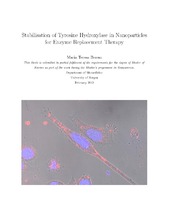| dc.contributor.author | Bezem, Maria Teresa | eng |
| dc.date.accessioned | 2012-04-24T08:22:17Z | |
| dc.date.available | 2012-04-24T08:22:17Z | |
| dc.date.issued | 2012-02-27 | eng |
| dc.date.submitted | 2012-02-27 | eng |
| dc.identifier.uri | https://hdl.handle.net/1956/5773 | |
| dc.description.abstract | The aim of this thesis has been to characterise nanoparticles (NPs) to which tyrosine hydroxylase (TH) was attached, as a preliminary step in their evaluation to be used for an enzyme replacement therapy (ERT) for Parkinson's disease (PD). TH is the enzyme catalysing the rate-limiting step in the synthesis of catecholamines, an important group of neurotransmitters. It converts dietary L- tyrosine to L-3,4-dihydroxyphenylalanine (L- DOPA). Levels of dopamine, one of the catecholamines, are low in the brain of patients with PD. Typical treatment is the supply of L- DOPA, at least short-term it improves the patient's quality of life, but also gives side effects and motor impairment after many years of use. A transport of TH to the brain is expected to naturally increase the amount of L-DOPA and dopamine if L-tyrosine and the cofactor tetrahydrobiopterin are present. This was the envisioned ERT in this project. The NPs were selected based on their ability to absorb large amounts of protein, to cross an in vitro model of the blood-brain barrier and because they consist mainly of cross-linked maltodextrin, a biodegradable polymer. TH used in this study was recombinant human enzyme, and we found that expression of TH in a fusion protein with a ZZ- carrier as a partner protein, provided a homogeneous, active enzyme at high yield. The binding between TH and the NPs was investigated by atomic force microscopy, size determination using dynamic light scattering and size exclusion chromotography. The changes in enzymatic activity of TH during a 24 hours time-lapse, were measured by an assay using radioactively labelled tyrosine, and the uptake of NP-bound TH into cells was evaluated by confocal microscopy. TH was found to be absorbed into the pores of the NPs upon titration with increasing concentration of TH, which showed a small but steady increase in the size of the NPs, as well as a phase change upon atomic force microscopy visualisation. TH's enzymatic activity was initially reduced by the NPs, but on the long run stabilised by them, and even further stabilisation was obtained in the presence of oxidative protecting enzymes or when inhibited by dopamine. Confocal imaging of TH with a fluorescent label, showed that all four different cell types that were tested, could take up TH only when it was bound to NPs. These results show the potential of these NPs to deliver TH and their potential application for ERT. | en_US |
| dc.description.abstract | Målet med denne masteroppgaven har vært å karakterisere nanopartikler som tyrosin hydroksylase har blitt bundet til, for å kunne evaluere om de kunne brukes til en enzymerstatningsterapi for Parkinson's sykdom. Tyrosin hydroxylase er et enzym som katalyserer den hastighetsbestemmende reaksjonen i syntesen av katekolaminene som er en viktig gruppe innenfor nevrotransmittere. Det katalyserer L-tyrosin fra kosten til L-3,4-dihydroksyfenylalanin. Nivået av dopamin, en av katekolaminene, er lavt i hjernen til Parkinsons pasienter. Typisk behandling er tilførsel av L-3,4-dihydroksyfenylalanin, som ved siden av en positiv innvirking på pasientenes liv, også har bivirkninger og gir problemer med motorikken etter langvarig bruk. Ved å transportere tyrosin hydroksylase til hjernen, kan nivået av både L-3,4-dihydroksyfenylalanin og dopamin økes på en naturlig måte, dersom kofaktoren tetrahydrobiopterin og L-tyrosin er tilstede. Dette var i sikte da ideen om enzymerstatningsterapi ble utarbeidet. Nanopartiklene ble valgt ut ifra deres egenskap til å kunne absorbere store mengder protein, krysse en in vitro model av blod-hjerne barrieren og fordi de er laget av polymerisert maltodekstrin som er bionedbrytbart. Bindingen mellom tyrosin hydroksylase og nanopartiklene ble studert ved hjelp av atomkraftmikroskop og størrelsesmålinger med dynamisk lysspredning og gelfiltreringskromotografi. Endringene i enzymaktiviteten til tyrosin hydroksylase over en 24 timers periode ble målt med radioaktiv stråling, og opptaket av nanopartikkelbundet tyrosin hydroksylase i celler ble evaluert i konfokalmikroskopet. Tyrosin hydroksylase var i dette prosjektet rekombinant humant enzym og vi fant ut at uttrykking av tyrosin hydroksylase som et fusjonsprotein sammen med et annet protein gav et homogent og aktiv enzym med høyest avkastning. Det ble funnet ut at nanopartiklene absorberer tyrosin hydroxylase ved observasjonen av en liten, men gjevn økning i nanopartikkelstørrelse under en konsentrasjontitrering av tyrosin hydroksylase. Tyrosin hydroksylases enzymaktivitet ble først redusert av nanopartiklene, men i det lange løpet stabilisert av dem og enda mer stabilisering ble oppnådd når enzymer som beskytter det oksidative miljøet var tilstede eller når tyrosin hydroksylase ble hemmet av dopamin. Konfokalbilder som ble tatt av fluorescerende tyrosin hydroksylase viser at all fire celletypene som ble testet kunne ta opp enzymet, men kun når det var bundet til en av nanopartiklene. Disse resultatene viser potensiale som disse nanopartiklene har til å levere tyrosin hydroksylase til hjernen og deres bruk i en enzymerstatningsterapi. | en_US |
| dc.format.extent | 8926161 bytes | eng |
| dc.format.mimetype | application/pdf | eng |
| dc.language.iso | eng | eng |
| dc.publisher | The University of Bergen | en_US |
| dc.subject | nanotechnology | eng |
| dc.subject | nanoscience | eng |
| dc.subject | Enzyme | eng |
| dc.subject | Tyrosine hydroxylase | eng |
| dc.subject | nanoparticles | eng |
| dc.subject | enzyme replacement therapy | eng |
| dc.title | Stabilisation of Tyrosine Hydroxylase in Nanoparticles for Enzyme Replacement Therapy | en_US |
| dc.type | Master thesis | |
| dc.description.localcode | MAMN-NANO | |
| dc.description.localcode | NANO399 | |
| dc.subject.nus | 752902 | eng |
| dc.subject.nsi | VDP::Medical disciplines: 700::Basic medical, dental and veterinary science disciplines: 710::Medical molecular biology: 711 | en_US |
| fs.subjectcode | NANO399 | |
